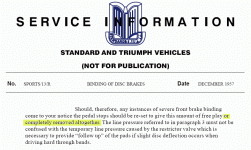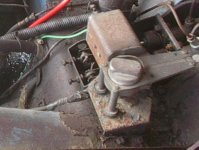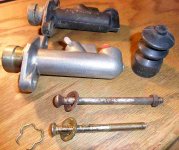CJD
Yoda
Offline
Hey guys,
I am having trouble deciphering the manual on pedal adjustment. The manual goes into a detailed instruction, which mainly concerns setting the pedal stops. The trouble is, my TR3A has no pedal stops.
The pushrods are captured in the master cylinders by snap rings. The book says to set .030" play between the pushod and the piston, which will give 1/2" play at the pedals. The deal is, if you shorten the adjustment, the max play is limited by the snap ring to about .024", or about 3/8" at the pedals. If you continue to shorten the adjustment, all you get is a lower pedal resting position. In other words, the adjustment makes no change to the freeplay...it only changes the resting position of the pedals.
So, how is this supposed to work? I assume on the later systems, like this, you must set the pedal height with the adjustment...instead of "free play"...as described in the manual? So then the question is, what is the pedal height I am looking for?
Thanks,
John
I am having trouble deciphering the manual on pedal adjustment. The manual goes into a detailed instruction, which mainly concerns setting the pedal stops. The trouble is, my TR3A has no pedal stops.
The pushrods are captured in the master cylinders by snap rings. The book says to set .030" play between the pushod and the piston, which will give 1/2" play at the pedals. The deal is, if you shorten the adjustment, the max play is limited by the snap ring to about .024", or about 3/8" at the pedals. If you continue to shorten the adjustment, all you get is a lower pedal resting position. In other words, the adjustment makes no change to the freeplay...it only changes the resting position of the pedals.
So, how is this supposed to work? I assume on the later systems, like this, you must set the pedal height with the adjustment...instead of "free play"...as described in the manual? So then the question is, what is the pedal height I am looking for?
Thanks,
John

 Hi Guest!
Hi Guest!

 smilie in place of the real @
smilie in place of the real @
 Pretty Please - add it to our Events forum(s) and add to the calendar! >>
Pretty Please - add it to our Events forum(s) and add to the calendar! >> 





